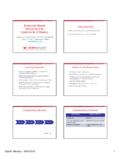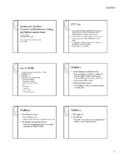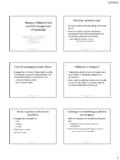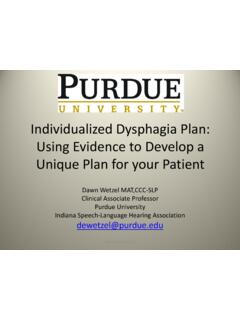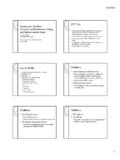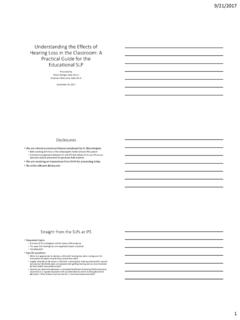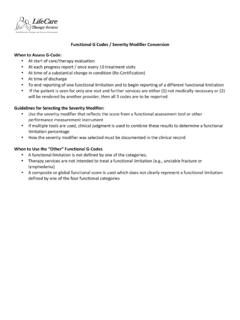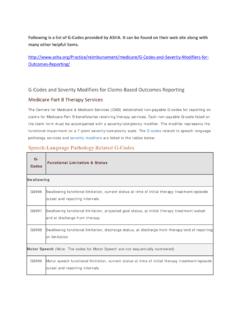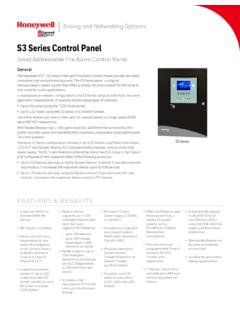Transcription of Kinder.1 - Indiana Speech-Language-Hearing …
1 4/1/20161 MEETINGTHEMEDICAREMARKR enee Kinder MS CCC SLP RAC CTIndiana Speech Language Hearing AssociationSaturday April 16th9:30 11:30 COURSEDESCRIPTIONP roviding high quality documentation of skilled services to Medicare beneficiaries begins with an adequate understanding of regulations set forth via the Medicare Benefit Policy Manual and Local Coverage Determinations (LCDs) in regards to key areas including: skilled versus non skilled procedures; traditional interventions versus maintenance based plans of care establishing interventions to promote return from baseline to prior level of function initiating caregiver training to promote carryover of skilled interventions upon discharge from care and documenting outcomes of reasonable and necessary services via goal targets which are functional and :1.
2 Participant will be able to create functional goal targets to promote reimbursement of servicesand evidence Participant will be able to identify key areas for documenting reasonable and necessary Participant will be able to describe procedures which support skilled : YOURFIRST DEFENSECODING KEEPINGCONTROLYOUR ST CLAIMEMRBOMPAYERCPT: Evaluation Codes4/1/2016292610 EVALUATION OFORAL& PHARYNGEALSWALLOWINGFUNCTIONM edicare Benefit Policy Manual (MBPM), Dysphagia Defined:Dysphagia, or difficulty in swallowing, can cause food to enter the airway, resulting in coughing, choking, pulmonary problems, aspiration or inadequate nutrition and hydration with resultant weight loss, failure to thrive, pneumonia and death.
3 It is most often due to complex neurological and/or structural impairments including head and neck trauma, cerebrovascular accident, neuromuscular degenerative diseases, head and neck cancer, dementias, and encephalopathies. For these reasons, it is important that only qualified professionals with specific training and experience in this disorder provide evaluation and treatment (1).MBPM, Swallowing Assessment Inclusions:Swallowing assessment and rehabilitation are highly specialized services. The professional rendering care must have education, experience and demonstrated competencies.
4 Competencies include but are not limited to: Identifying abnormal upper aerodigestivetract structure and function Conducting an oral, pharyngeal, laryngeal and respiratory function examination as it relates to the functional assessment of swallowing Recommending methods of oral intake and risk precautions Developing a treatment plan employing appropriate compensations and therapy techniques (2).NEWEVALUATIONCODES2014 BackgroundEffective January 1, 2014, Current Procedural Terminology (CPT, American Medical Association) for code 92506 (Evaluation of speech, language, voice, communication, and/or auditory processing) will be deleted and replaced with four new, more specific evaluation codes related to language, speech sound production, voice and resonance, and fluency START USINGTHENEWCODES?
5 You should have started using the new codes for billing patients on or after January 1, 2014. WHYDIDFOURNEWCODESREPLACECPT 92506? The four new evaluation codes were developed by ASHA's Health Care Economics Committee (HCEC)in collaboration with experts in the field from ASHA's Special Interest Groups. The HCEC has been working with the American Medical Association (AMA) to change most speech language pathology codes since 2009, when a new law took effect that allows private practice SLPs to bill Medicare directly for their services.
6 Because of that change, the AMA's Relative Value Update Committee re evaluated speech language pathology codes to include "professional work" value (one of three components of a code's value that reflects the amount of time, technical skill, physical effort, stress, and judgment required to provide the service). Prior to 2009, SLPs were considered "technical support" and their work was included in the "practice expense" component of the code's reimbursement formula. During this process, the RUC recognized that CPT 92506 reflected more than one procedure.
7 This recognition gave ASHA an opportunity to develop specific evaluation procedure codes to replace 92506 and more accurately and appropriately value the professional work 92521 Evaluation of speech fluency ( , stuttering, cluttering) 92522 Evaluation of speech sound production ( , articulation, phonological process, apraxia, dysarthria) 92523 Evaluation of speech sound production ( , articulation, phonological process, apraxia, dysarthria); with evaluation of language comprehension and expression ( , receptive and expressive language) 92524 Behavioral and qualitative analysis of voice and resonanceCANNEWCODESBEBILLEDTOGETHERSAME DAY?
8 The CPT Handbookdoes not include language to restrict an SLP's ability to bill these codes together because there are circumstances when it is appropriate for a patient to be evaluated for multiple disorders on the same day. Note In those cases, documentation should clearly reflect a complete and distinct evaluation for each disorder. 4/1/2016392521 EVALUATION OFSPEECHFLUENCY Inclusions Evaluation of Stuttering and Cluttering The following disorders are typically non covered for the geriatric Medicare beneficiary.
9 Fluency disorder Dysprosody Stuttering and cluttering (except neurogenic stuttering caused by acquired brain damage)92522 EVALUATION OFSPEECHSOUNDPRODUCTION Inclusions Articulation, Phonological Process, Apraxia, Dysarthria92523 EVAL OFSPEECHSOUNDPRODUCTIONWITHEVAL OFLANGUAGECOMPREHENSIONANDEXPRESSION Inclusions Articulation, Phonological Processes, Apraxia, Dysarthria; Receptive and Expressive Language92523 ISCOMBINEDSPEECHSOUNDPRODUCTIONANDLANGUA GE? WHATIFI ONLY EVALUATE LANGUAGE? If two or more procedures are billed together at least 51% of the time, it is standard to develop a bundled CPT code for that set of services.
10 ASHA surveyed practices and clinics and confirmed that evaluations for language are accompanied by evaluations for speech sound production 80% of the time. However, the reverse is not true. It is common for speech sound production abilities to be evaluated independent of a language evaluation, which is why there is a stand alone code for speech sound production evaluation. If a patient is evaluated only for language, SLPs should bill 92523 with the 52 modifier, which is used when the services providedare reduced in comparison with the full description of the service.
